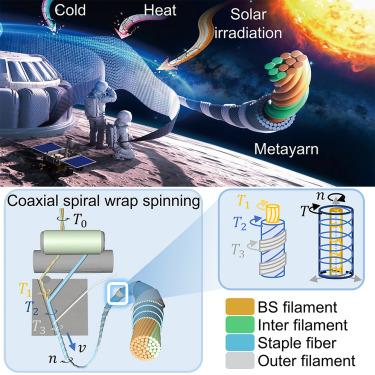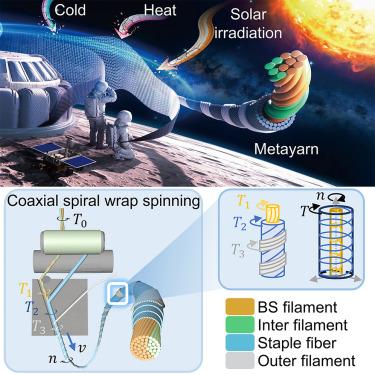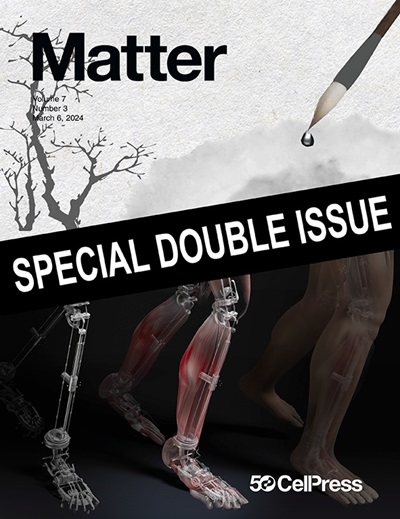用于人体工学防护空间纺织品的分层玄武岩元纤维
IF 17.5
1区 材料科学
Q1 MATERIALS SCIENCE, MULTIDISCIPLINARY
引用次数: 0
摘要
太空纺织品必须能抵抗极冷、极热和太阳辐射。玄武岩纤维具有极强的耐环境性和低廉的成本,是太空殖民的最佳材料。然而,它们太脆,无法在纺纱和织物形成过程中不受损害,而容易成为纱线的柔性有机纤维在太空中不安全。本研究发明了一种同轴螺旋缠绕纺丝方法,通过在双螺旋玄武岩岩芯上以无损无扭矩的方式分层缠绕阻燃护套纤维,形成全护套覆盖、双向分层螺旋和最大芯鞘界面力的Metayarn结构。因此,Metayarns具有足够的柔韧性、强度和稳定性,可以编织成柔软的织物,抵御强烈的太阳照射、极低和高温(- 200°C - 300°C)以及1300°C的火焰。这种符合人体工程学的织物具有成本效益高、可染色、亲肤、柔韧等特点,并且具有421%的拉伸性和耐磨性。因此,这种织物有望在月球上用作宇航服、帐篷和旗帜。本文章由计算机程序翻译,如有差异,请以英文原文为准。


Hierarchical basalt metayarn for ergonomic protective space textiles
Space textiles must resist extreme cold, heat, and solar irradiation. Basalt fibers with extreme environmental resistance and low cost are the optimal materials for space colonization. However, they are too brittle to spin without damage for forming yarn and fabric, while flexible organic fibers that easily become yarn are not safe for space. This study invents a coaxial spiral wrapping spinning method to form a structure of full sheath-coverage, bidirectional hierarchical helix, and maximum core-sheath interfacial force in Metayarn by hierarchically wrapping fire-retardant sheath fibers onto double-helical basalt cores in a nondestructive and torque-free way. Thus, Metayarns are flexible, strong, and stable enough to be knitted into soft fabrics that defend against strong solar irradiation, extremely low and high temperatures (−200°C–300°C), and 1300°C flame. The ergonomic fabrics are cost-effective, dyeable, skin-friendly, and flexible, and they also have 421% stretchability and abrasion durability. Therefore, the fabrics are expected to serve as space suits, tents, and flags on the moon.
求助全文
通过发布文献求助,成功后即可免费获取论文全文。
去求助
来源期刊

Matter
MATERIALS SCIENCE, MULTIDISCIPLINARY-
CiteScore
26.30
自引率
2.60%
发文量
367
期刊介绍:
Matter, a monthly journal affiliated with Cell, spans the broad field of materials science from nano to macro levels,covering fundamentals to applications. Embracing groundbreaking technologies,it includes full-length research articles,reviews, perspectives,previews, opinions, personnel stories, and general editorial content.
Matter aims to be the primary resource for researchers in academia and industry, inspiring the next generation of materials scientists.
 求助内容:
求助内容: 应助结果提醒方式:
应助结果提醒方式:


